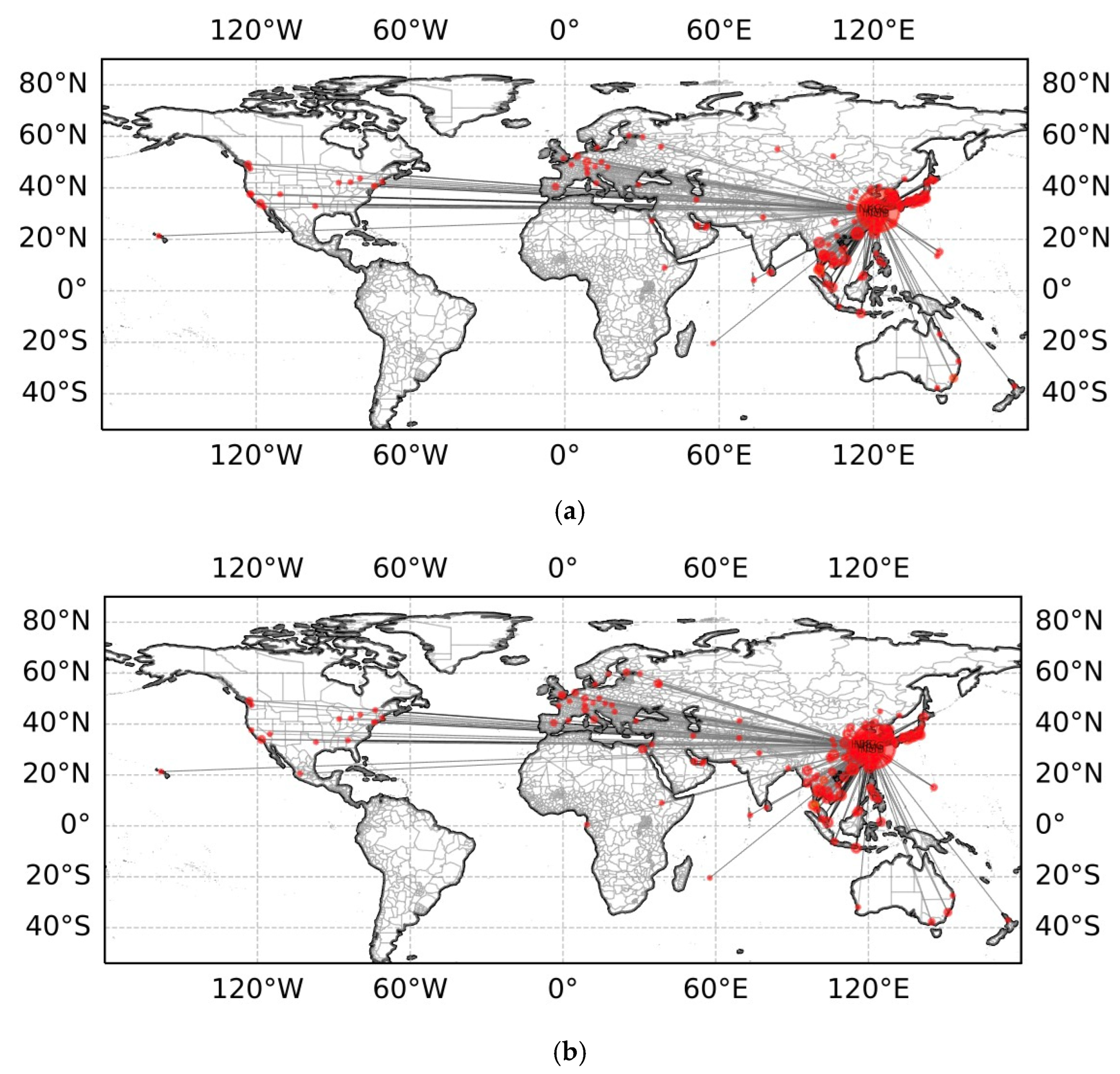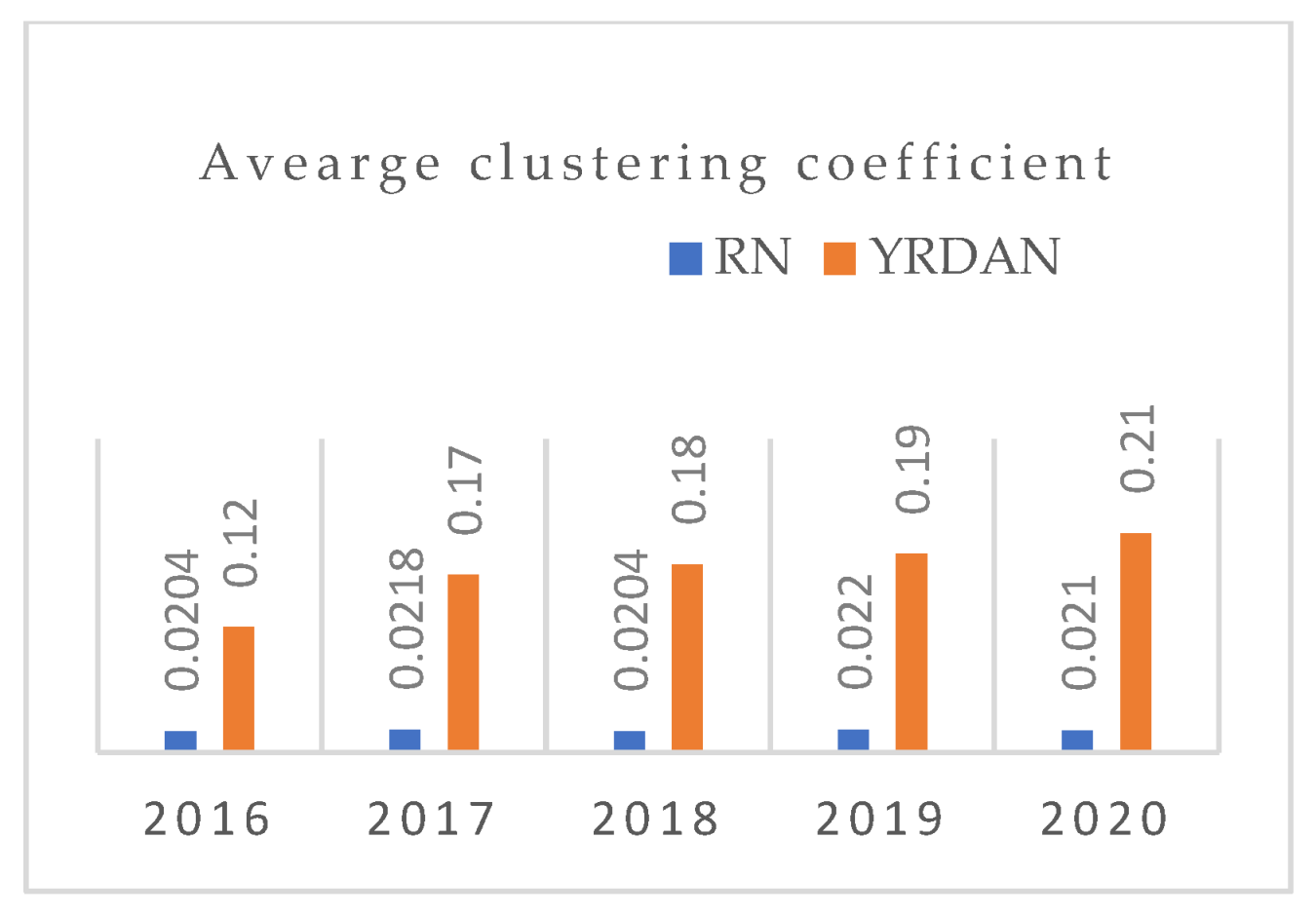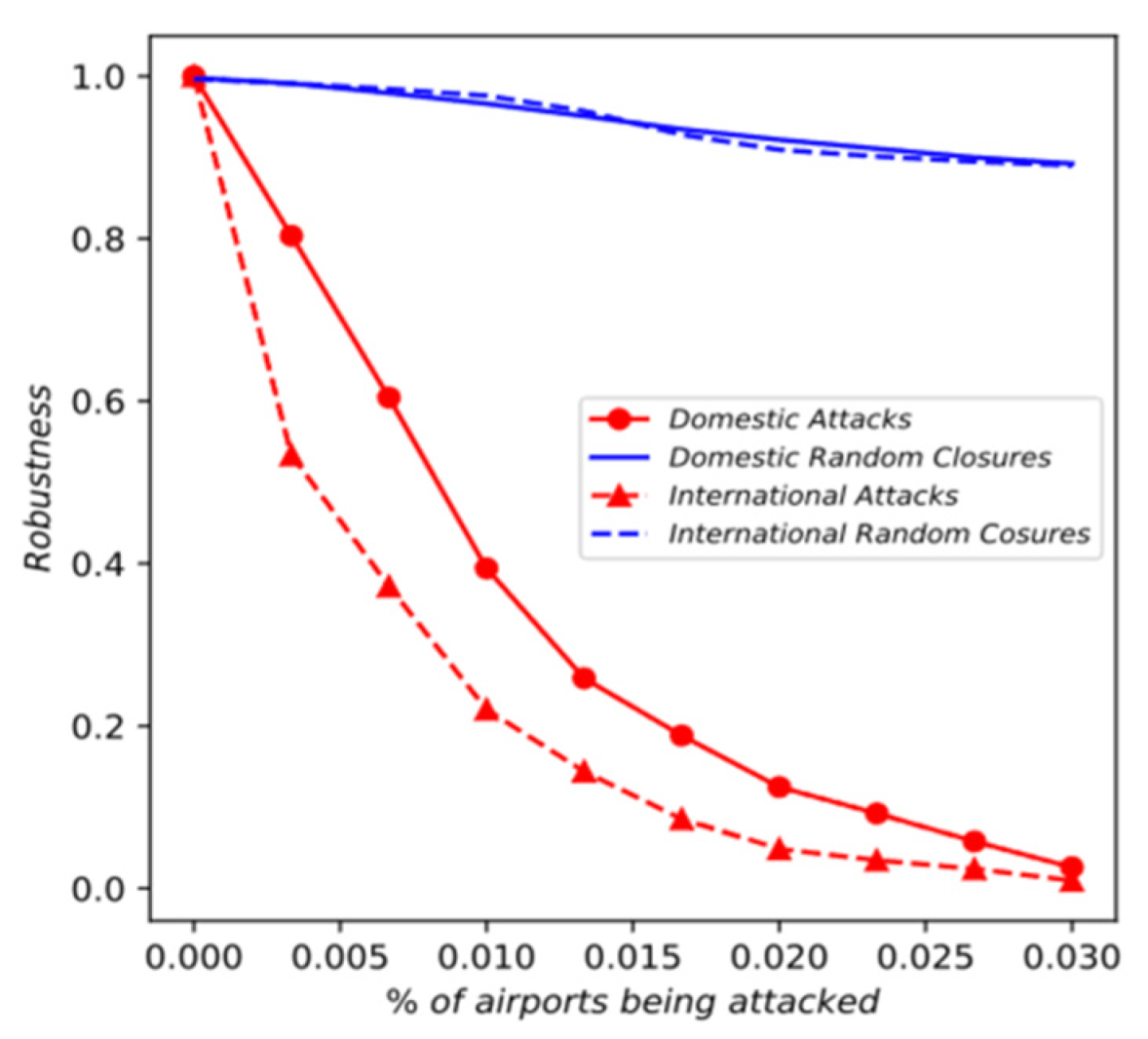Topology and Robustness of Weighted Air Transport Networks in Multi-Airport Region
Abstract
:1. Introduction
2. Literature Review
3. Methodology
3.1. YRDAN Representation
3.2. Network Structure Measures
3.2.1. Node Degree and Distribution
3.2.2. Average Shortest Path Length
3.2.3. Clustering Coefficient
3.2.4. Centrality
3.3. Robustness Assessment
4. Results
4.1. Analysis of Structure
4.2. Analysis of Topology
4.3. Analysis of Robustness
5. Conclusions and Implications
5.1. Conclusions
5.2. Implications
Author Contributions
Funding
Institutional Review Board Statement
Informed Consent Statement
Data Availability Statement
Conflicts of Interest
References
- IATA. Annual Review 2019; IATA: Montreal, QC, Canada, 2019. [Google Scholar]
- IATA. 2018 in Review—Air Passenger Volumes; IATA: Montreal, QC, Canada, 2018. [Google Scholar]
- Guimera, R.; Amaral, L. Modeling the world-wide airport network. Eur. Phys. J. B-Condens. Matter Complex Syst. 2004, 38, 381–385. [Google Scholar] [CrossRef]
- Wang, J.; Mo, H.; Wang, F.; Jin, F. Exploring the network structure and nodal centrality of China’s air transport network: A complex network approach. J. Transp. Geogr. 2011, 19, 712–721. [Google Scholar] [CrossRef]
- Du, W.B.; Zhou, X.L.; Lordan, O.; Wang, Z.; Zhao, C.; Zhu, Y.B. Analysis of the Chinese Airline Network as multi-layer networks. Transp. Res. Part E Logist. Transp. Rev. 2016, 89, 108–116. [Google Scholar] [CrossRef] [Green Version]
- Hossain, M.M.; Alam, S. A complex network approach towards modeling and analysis of the Australian Airport Network. J. Air Transp. Manag. 2017, 60, 1–9. [Google Scholar] [CrossRef]
- Lordan, O.; Jose, M.S. Core and critical cities of global region airport networks. Phys. A 2019, 513, 724–733. [Google Scholar] [CrossRef]
- Kim, S.; Yoon, Y. On node criticality of the Northeast Asian air route network. J. Air Transp. Manag. 2019, 80, 101693. [Google Scholar] [CrossRef]
- Gilbert, E.N. On random graphs. Publ. Math. Debrecen 1959, 30, 1141–1144. Available online: https://www.jstor.org/stable/2237458 (accessed on 31 May 2022). [CrossRef]
- Barabási, A.-L.; Albert, R. Emergence of scaling in random networks. Science 1999, 286, 509–512. [Google Scholar] [CrossRef] [Green Version]
- Watts, D.J.; Strogatz, S.H. Collective dynamics of ‘small-world’ networks. Nature 1998, 393, 440–442. [Google Scholar] [CrossRef]
- Xie, F.; Levinson, D. Modeling the growth of transportation networks: A comprehensive review. Netw. Spat. Econ. 2009, 9, 291–307. [Google Scholar] [CrossRef] [Green Version]
- Seaton, K.A.; Hackett, L.M. Stations, trains and small-world networks. Phys. A 2004, 339, 635–644. [Google Scholar] [CrossRef] [Green Version]
- Latora, V.; Marchiori, M. Is the Boston subway a small-world network? Phys. A Stat. Mech. Appl. 2002, 314, 109–113. [Google Scholar] [CrossRef] [Green Version]
- Ducruet, C.; Notteboom, T. The worldwide maritime network of container shipping: Spatial structure and regional dynamics. Global Netw. 2012, 12, 395–423. [Google Scholar] [CrossRef] [Green Version]
- Bagler, G. Analysis of the airport network of India as a complex weighted network. Phys. A 2008, 387, 2972–2980. [Google Scholar] [CrossRef] [Green Version]
- Guida, M.; Maria, F. Topology of the Italian airport network: A scale-free small-world network with a fractal structure? Chaos. Soliton. Fract. 2007, 31, 527–536. [Google Scholar] [CrossRef]
- Guimerà, R.; Mossa, S.; Turtschi, A.; Amaral, L.A.N. The worldwide air transportation network: Anomalous centrality, community structure, and cities’ global roles. Proc. Nat. Acad. Sci. USA 2005, 102, 7794–7799. [Google Scholar] [CrossRef] [Green Version]
- Newman, M.E.J. The structure and function of complex networks. SIAM Rev. 2003, 45, 167–256. [Google Scholar] [CrossRef] [Green Version]
- Rocha, L.E.D. Structural evolution of the Brazilian airport network. J. Stat. Mech. 2009, 2009, P04020. [Google Scholar] [CrossRef]
- Wandelt, S.; Sun, X. Evolution of the international air transportation country network from 2002 to 2013. Transp. Res. E. 2015, 82, 55–78. [Google Scholar] [CrossRef]
- Córdoba, H.A. The evolution of Cuba’s air transport network in the Embargo Era: 1967–2017. J. Transp. Geogr. 2022, 98, 103259. [Google Scholar] [CrossRef]
- Lordan, O.; Sallan, J.M.; Simo, P. Study of the topology and robustness of airline route networks from the complex network approach: A survey and research agenda. J. Transp. Geogr. 2014, 37, 112–120. [Google Scholar] [CrossRef]
- Economía América. España Calcula Costos de la Huelga de los Controladores Aéreos. 2010. Available online: https://www.americaeconomia.com/ (accessed on 31 May 2022).
- NewStatesman. Snow and Strikes Cost Easyjet £31m. 2011. Available online: https://www.telegraph.co.uk/ (accessed on 31 May 2022).
- Sina Finance. Economic Losses by Flight Delays Could Be as Much as $100 Billion a Year. 2013. Available online: https://www.cnbc.com/world/ (accessed on 31 May 2022).
- Zhou, Y.; Sheu, J.B.; Wang, J. Robustness assessment of urban road network with consideration of multiple hazard events. Risk Anal. 2017, 37, 1477–1494. [Google Scholar] [CrossRef] [PubMed]
- Reggiani, A. Network resilience for transport security: Some methodological considerations. Transp. Policy 2013, 28, 63–68. [Google Scholar] [CrossRef]
- Sun, X.; Gollnick, V.; Wandelt, S. Robustness analysis metrics for worldwide airport network: A comprehensive study. Chin. J. Aeronaut. 2017, 30, 500–512. [Google Scholar] [CrossRef]
- Shiyan, L.I.U.; Zhenfu, L.I.; Zhong, J.; Daqing, L.I. Percolation transition in temporal airport network. Chin. J. Aeronaut. 2020, 33, 219–226. [Google Scholar]
- Crucitti, P.; Latora, V.; Marchiori, M.; Rapisarda, A. Efficiency of scale-free networks: Error and attack tolerance. Phys. A 2003, 320, 622–642. [Google Scholar] [CrossRef] [Green Version]
- Chi, L.P.; Cai, X. Structural changes caused by error and attack tolerance in US airport network. Int. J. Mod. Phys. B 2004, 18, 2394–2400. [Google Scholar] [CrossRef]
- Zhou, Y.; Wang, J.; Huang, G.Q. Efficiency and robustness of weighted air transport networks. Transp. Res. E 2019, 122, 14–26. [Google Scholar] [CrossRef]
- Lordana, J.M.; Sallana, P.; Simoa, D.G. Prietob. Robustness of the air transport network. Transp. Res. E 2014, 68, 155–163. [Google Scholar] [CrossRef]
- Lordan, J.M. Sallan. Analyzing the multilevel structure of the European airport network. Chin. J. Aeronaut. 2017, 30, 554–560. [Google Scholar] [CrossRef] [Green Version]
- Du, W.-B.; Zhang, M.-Y.; Zhang, Y.; Cao, X.-B.; Zhang, J. Delay causality network in air transport systems. Transp. Res. E 2018, 118, 466–476. [Google Scholar] [CrossRef]
- Lu, F.; Liu, K.; Duan, Y.; Cheng, S.; Du, F. Modeling the heterogeneous traffic correlations in urban road systems using traffic-enhanced community detection approach. Phys. A 2018, 501, 227–237. [Google Scholar] [CrossRef]
- Qian, B.; Zhang, N.; Wu, C. Estimate spatial spillover of airport operational efficiency in the YRD region. Sustainability 2022, 14, 1019. [Google Scholar] [CrossRef]
- O’Connor, K.; Fuellhart, K. Airports and regional air transport markets: A new perspective. J. Transp. Geogr. 2016, 53, 78–82. [Google Scholar] [CrossRef]
- Cheung, K.Y.; Wong, W.H.; Zhang, A.; Wu, Y. Spatial panel model for examining airport relationships within multi-airport regions. Transp. Res. Part A Policy Pract. 2020, 133, 148–163. [Google Scholar] [CrossRef]
- Lin, J.; Ban, Y. The evolving network structure of US airline system during 1990–2010. Phys. A Stat. Mech. Its Appl. 2014, 410, 302–312. [Google Scholar] [CrossRef]
- Sun, X.; Wandelt, S.; Linke, F. Temporal evolution analysis of the European air transportation system: Air navigation route network and airport network. Transp. B 2015, 3, 153–168. [Google Scholar] [CrossRef]
- Barrat, A.; Barthelemy, M.; Vespignani, A. Weighted evolving networks: Coupling topology and weight dynamics. Phys. Rev. Lett. 2004, 92, 228701. [Google Scholar] [CrossRef] [Green Version]
- Costa, L.; Rodrigues, F.; Travieso, G.; Boas, P. Characterization of complex networks: A survey of measurements. Adv. Phys. 2007, 56, 167–242. [Google Scholar] [CrossRef] [Green Version]
- Opsahl, T.; Panzarasa, P. Clustering in weighted networks. Soc. Netw. 2009, 31, 155–163. [Google Scholar] [CrossRef]
- Lordan, O.; Sallan, J.M.; Escorihuela, N.; Gonzalez-Prieto, D. Robustness of airline route networks. Phys. A. 2016, 445, 18–26. [Google Scholar] [CrossRef] [Green Version]
- Xu, Z.; Harriss, R. Exploring the structure of the US intercity passenger air transportation network: A weighted complex network approach. Geo. J. 2008, 73, 87. [Google Scholar]
- Lordan, O.; Sallan, J.M.; Simo, P.; Gonzalez-Prieto, D. Robustness of airline alliance route networks. Commun. Nonlinear Sci. Numer. Simul. 2015, 22, 587–595. [Google Scholar] [CrossRef] [Green Version]
- Latora, V.; Marchiori, M. Efficient behavior of small-world networks. Phys. Rev. Lett. 2001, 87, 198701. [Google Scholar] [CrossRef] [Green Version]
- Dai, L.; Ben, D.; Liu, X. The evolving structure of the Southeast Asian air transport network through the lens of complex networks, 1979–2012. J. Transp. Geogr. 2018, 68, 67–77. [Google Scholar] [CrossRef]
- Barabási, A.-L.; Pósfai, M. Network Science; Cambridge University Press: Cambridge, UK, 2016. [Google Scholar]
- Xin, C.; Xinru, L.; Yin, S. Characteristics of aviation network in Yangtze River Delta based on complex network. J. Transp. Inf. Safety 2020, 35, 139–146. [Google Scholar]
- Yu, C.; Wang, J.; Jin, F. Robustness of China’s air transport network from 1975 to 2017. Phys. A 2020, 539, 122876. [Google Scholar]








| Network | Reference | |||||
|---|---|---|---|---|---|---|
| World | [3] | 3663 | 27,051 | 4.4 | 0.62 | Power law |
| Southeast Asia | [50] | 237 | 602 | 3.12 | 0.21 | Power law |
| US | [50] | 272 | 6566 | 1.84–1.93 | 0.73–0.78 | Power law |
| Italy | [17] | 42 | 310 | 1.98–2.14 | 0.07–0.1 | Pareto |
| India | [16] | 79 | 228 | 2.26 | 0.66 | Power law |
| Australia | [6] | 131 | 596 | 2.9 | 0.5 | Power law |
| China | [4] | 144 | 1018 | 2.23 | 0.69 | Exponential |
| YRD region | 300 | 973 | 2.2 | 0.21 | Power law |
| Rank | Degree centrality | Closeness Centrality | Betweenness Centrality |
|---|---|---|---|
| 1 | Shanghai | Shanghai | Shanghai |
| 2 | Hangzhou | Nanjing | Hangzhou |
| 3 | Nanjing | Ningbo | Nanjing |
| 4 | Ningbo | Hefei | Ningbo |
| 5 | Hefei | Hangzhou | Hefei |
| 6 | Wuxi | Yancheng | Wuxi |
| 7 | Nantong | Guangzhou | Nantong |
| 8 | Yancheng | Changchun | Yancheng |
| 9 | Changzhou | Chongqing | Changzhou |
| 10 | Yiwu | Chengdu | Yiwu |
Publisher’s Note: MDPI stays neutral with regard to jurisdictional claims in published maps and institutional affiliations. |
© 2022 by the authors. Licensee MDPI, Basel, Switzerland. This article is an open access article distributed under the terms and conditions of the Creative Commons Attribution (CC BY) license (https://creativecommons.org/licenses/by/4.0/).
Share and Cite
Qian, B.; Zhang, N. Topology and Robustness of Weighted Air Transport Networks in Multi-Airport Region. Sustainability 2022, 14, 6832. https://doi.org/10.3390/su14116832
Qian B, Zhang N. Topology and Robustness of Weighted Air Transport Networks in Multi-Airport Region. Sustainability. 2022; 14(11):6832. https://doi.org/10.3390/su14116832
Chicago/Turabian StyleQian, Bingxue, and Ning Zhang. 2022. "Topology and Robustness of Weighted Air Transport Networks in Multi-Airport Region" Sustainability 14, no. 11: 6832. https://doi.org/10.3390/su14116832
APA StyleQian, B., & Zhang, N. (2022). Topology and Robustness of Weighted Air Transport Networks in Multi-Airport Region. Sustainability, 14(11), 6832. https://doi.org/10.3390/su14116832





